Brian Solis's Blog, page 2
November 6, 2025
The Next Shift: From Workflows to Outcomes in the Agentic Age

Screenshot
When I sat down with Jaeden Schaefer on the AI Chat podcast, we didn’t talk about the latest AI trends, instead, we talked about a deeper inflection: moving from pilots that keep AI in a corner of the enterprise to agentic, end-to-end flows that actually do the work, learn from it, and elevate what people are free to do next.
Join host Jaeden Schafer as he welcomes Brian Solis, Head of Global Innovation at ServiceNow, to discuss the transformative power of AI in enterprise workflows. Discover how AI is reshaping industries, the importance of human orchestration, and the future of work in a rapidly evolving technological landscape.
Automation + augmentation (by design)I’m bullish on automation that removes the drudgery, especially when companies do something intentional with freed up time, space, and resources.. I’m also focused on augmentation, the intentional actions that give people AI superpowers with directives toward exponential outcomes.
The new human role: orchestrationAs agents take on work, a new job emerges: human orchestration. Think conductor, not operator. Design flows. Set guardrails. Monitor exceptions. Tune prompts and policies. Measure value per run, first-pass yield, and exceptions contained. And keep humans in, or above, the loop where judgment creates outsized value.
Browsers become co-pilots and auto-pilotsA small story with big implications: I asked Atlas to scout impossible-to-book NYC restaurants, navigate reservations, and track openings. Watching it reason and act across sites made one thing obvious: the browser is no longer a window, it’s a co-pilot and, with training, an auto-pilot for getting things done and eventually, getting them done autonomously.
These new browsers reconfigure discovery and decision-making for consumers and enterprises alike.
You can watch my Atlas test below the podcast video.
Mindshift: design from the outcome backStart with the outcome, quality, speed, cost, and risk, then design backward. Connect the full flow, give agents room to operate, and instrument learning so every run gets smarter. Most importantly, redeploy the time you free into deeper service, creativity, and relationships.
Performance gaps (and how to avoid them)There’s a growing delta between people who use AI to amplify their judgment and those who quietly offload their thinking. That gap becomes disruption, at the individual and enterprise level.
Your move: Pick an end-to-end flow.Stand up a control-tower view. Run with humans in and above the loop. Measure compounding value. And protect the one thing AI can’t replace: your originality.
This is your moment to change the trajectory of your role with AI.
Listen on Youtube, Spotify or Apple Podcasts.
Watch below 
| Keynote Speaker | Newsletter
The post The Next Shift: From Workflows to Outcomes in the Agentic Age appeared first on Brian Solis.
November 5, 2025
fastforward: Becoming an AI-first business requires a total organizational mindshift, an interview with Brian Solis
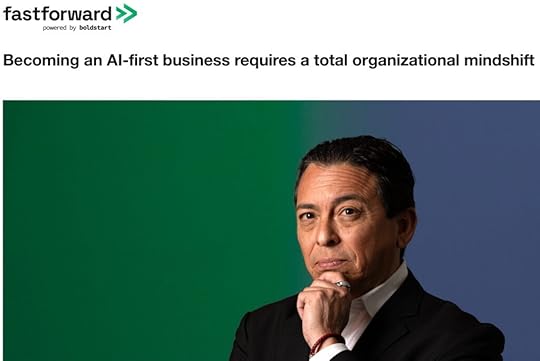
Ron Miller and Brian Solis explored what it means to be an AI-first company moving forward for fastforward, powered by boldstart…
Just about every organization wants to be an AI-first company right now, but making every part of the business run on AI is easier said than done. If history’s any guide, past digital transformation efforts showed how a lack of organizational buy-in can sink even the best intentions.
Brian Solis, head of global innovation at ServiceNow, and author of the book Mindshift, says his research found that one of the main reasons digital transformation projects didn’t pan out was looking at the process as an IT problem. That often led to digitizing certain parts of the business, which was fine as far as it went, but the impact rarely spread across the entire company.
“My counter to that research was to show what successful digital transformation looked like from a business standpoint. By analyzing the models of Amazon or Uber or Airbnb, I showed that if you put digital at the center of your business, this is what transformation could look like,” Solis told FastForward.
In his view, the key to any successful change is not confining it to a single group, but making it an end-to-end, enterprise-wide effort that actually alters the way you do business in a positive way. And the same principle applies to working toward becoming AI-first. You can’t look at it as a technology project. It requires a shift in organizational thinking that starts at the top and works its way through the entire company.
Making the shiftBox CEO Aaron Levie agrees that companies have to be thinking about what it means to be AI-first. “It’s really this idea that everything we do should be aided by AI and in the service of accelerating our work,” he said. If it works as described, that should result in faster, more intelligent decision making, while letting companies bring more products to market more quickly.
“The output of the organization should go up on a per-person basis, and we should be able to use AI to get that output to go up,” he said. And as that happens, he believes it will have a ripple effect across the company. It’s worth pointing out that few organizations to this point have achieved this level of change yet, but that is the goal, at least.
While Levie has articulated the vision, Solis looks at the frameworks to get there. He believes that you can’t reach Levie’s ideal by simply redesigning existing work processes. “AI cannot work in the box of business as usual. It really requires actual transformation, mostly from a data standpoint, which then involves breaking down silos and rethinking operational structures,” he said.
That means not only getting your data house in order, which is essential to successfully implementing AI projects, but also reimagining how your business could work in the age of AI. Solis says that requires a new kind of leader, one who could actually come from anywhere in the company, not just in the C-suite.
Finding the mavericksThe people who lead substantive organizational change like digital transformation or becoming AI-first may or may not be executives. They could be any employee who sees a better way to do things and leads by example, ignoring the noise and plowing forward, often bucking conventional wisdom. Solis calls these folks ‘change agents,’ anyone who is a “believer in and catalyst of progress; this is a person who sees a better future and is on the cusp of becoming a leader,” Solis wrote in Mindshift.
These are people who Jeff Bezos calls ‘mavericks,’ people who challenge the status quo. “[Successful companies] figure out how to support them and keep them driving change inside the company. Because really, most big companies get comfortable, and the mavericks cause discomfort, and so it’s easy to keep them away and kind of drive them out, but you’ll lose so much that way,” Bezos said recently at an Italian Tech Week interview.
AI cannot work in the box of business as usual.
Solis says most leaders lean on the familiar — their experience (the way it’s always been done), the board (the protectors of the known and routine) or the inner circle who probably won’t question the leader’s narrative. Fear of change leads to incremental programs instead of bold shifts, and it takes these special individuals to push through that.
Right now, we’re seeing a recurring problem with AI adoption where companies skip the hard work like prepping their internal data, while rushing into proof-of-concept projects, and finally falling back to status quo when results disappoint. “If it’s not showing true business impact, which is how we look at AI or any digital tool, as a cost-cutting tool for efficiency versus the unknown piece that could potentially unlock innovation, growth and business value,” he said.
In Mindshift, Solis not only defines the problems companies face, but also offers models for exploring meaningful change. “When you’re seeing answers or insights or you curate curious bits, you actually have a mechanism to expand it,” Solis explained.
All of this is to say, you can’t embrace big changes unless you see the possibilities a positive outcome could bring. “So that shift from self-awareness to ‘I don’t know what I don’t know,’ to imagination and curiosity, and then to building that framework — that’s the mind shift.”
| Keynote Speaker | Newsletter
The post fastforward: Becoming an AI-first business requires a total organizational mindshift, an interview with Brian Solis appeared first on Brian Solis.
November 3, 2025
AI Will Expose Leaders Who Think Like Machines: The Future Belongs to Architects of Possibility
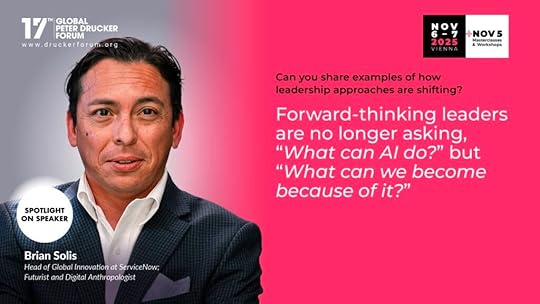
It’s been a dream to meet my idols, fellow peers, and also present at the Global Peter Drucker Forum. In 2024, Richard Straub and Julia Kirby made that dream a reality. And in 2024, we were just about two years into generative AI disruption that continues to disrupt enterprises and management thinking globally.
I’m proud, and more than ready, to return in 2025. And in the one short year it’s been since I’ve last joined this incredible group of academics, business leaders, my work at ServiceNow has focused on further documenting enterprise AI maturity, I published my first book in five years, Mindshift: Transform Leadership, Drive Innovation, and Reshape the Future, and I’ve launched several new initiatives that study how executives are, and should navigate AI business transformation.
In the lead-up to the 2025 Global Peter Drucker Forum, I spent time with the crew organizing the event. They worked with this year’s speakers to better understand how to help attendees and those they represent navigate the next year ahead. Here’s what I had to say, and I didn’t hold back…
Whether you’re attending the event, and I hope to see you if you are, or not, I’m sharing this unabridged interview with you so we can influence what happens next, together. 
We invite you to share your perspective on our annual topic, “Next Era Leadership: All Hands on Deck,” by reflecting on the following questions…
Q: Can you please share 5 sentences that describe your session:1. We stand at the threshold of a new leadership era, one where AI is exposing the limits of legacy thinking and legacy leadership, but the first stop for any “leader” is self-awareness…to ask themselves:
“Are we using AI to improve the past or invent the future?”
“Do we deploy AI to shrink our workforce, automate yesterday’s work, and chase quarterly gains or do we use AI to augment human potential, pursue exponential outcomes and gains, and invent entirely new sources of value?”
2. Peter Drucker said, “The greatest danger in times of turbulence is not the turbulence; it is to act with yesterday’s logic.” AI is that turbulence, and while many leaders respond with yesterday’s logic, the invitation to define the future is to lead with tomorrow’s logic. It starts with a mindset shit or a ‘mindshift.’
3. The future doesn’t need more managers to manage against yesterday’s processes, work, and standards; it needs architects of possibility who can lead in an age of intelligent machines and infinite potential. We need leaders willing to imagine, wonder, ask new questions and empower people around them to do the same.
4. AI doesn’t change businesses, leaders who dare to imagine business differently will use AI to change the business. It starts by rewriting the human algorithm of leadership itself, from management by control to leadership by curiosity, empathy, and empowerment. The true potential for next leadership is unleashed in how human creativity and machine intelligence can work in harmony to achieve what neither could alone.
5. In the next leadership era, success won’t come from scaling efficiency, but from scaling imagination… rethinking value creation, culture, and management itself through the lens of AI and augmentation.
Bonus: Drucker believes that the most valuable asset of a 21st century institution is its knowledge workers and their productivity. AI offers the ability to do more than automate repetitive tasks and improve productivity, to break free from static knowledge work…to imagine AI as a collaborator and a catalyst for enabling outcomes not possible before. If AI can do what you do, then what is it that you contribute? Knowledge now is about how fast you can learn, unlearn, imagine, and apply new creativity and understanding.
Q: How does your work help reshape management practices?I base a lot of my work, thinking, and experimentation on the disruptions happening in Silicon Valley by AI Native and AI First companies.
My work challenges leaders to see AI not as a technology to manage but as a catalyst to reimagine management itself. We start by embracing an “AI Forward Mindset.” This means means prioritizing the use of AI in exploring possibilities not achievable without it…and outcomes AI couldn’t achieve without you.
For too long, we’ve optimized for efficiency and productivity, not potential or the unknown. AI gives us the mirror to reflect on self-awareness, vision, and self-actualization. I outline what was, what is, and what could be with AI to redesign work, culture, and leadership around creativity, empathy, and adaptability….to iterate by automating yesterday and innovation by augmenting possibility and exploring new value creation.
In Mindshift, I write that transformation begins not with technology, but with mindset. Management must evolve from directing resources to developing new capacities, human and digital alike.
In Drucker’s terms, we must stop “doing things right” and start “doing the right things.” In an era when AI can perform much of yesterday’s work, we must imagine and do things differently.
For decades, management has been about optimizing for efficiency, doing things right, taking out costs, scaling capacity, increase speed. But in the age of intelligent machines, doing things right is the new status quo, just powered by AI. We must learn to do the right things differently.
Moving forward, it’s a balance of iterative AI and innovative AI.
Iterative AI strategies are purpose-built to solve real business challenges and improve everyday workflows. It removes the routine and complex, enabling faster, more efficient, productive, value-added work. Innovative AI investments aim to create entirely new products, services, or business models. It enables organizations to reimagine value creation by uncovering opportunities that were previously impossible or impractical, leading to exponential growth and competitive differentiation.
Q: What’s your ideal or utopian vision for the future of management?My utopian vision is one where management becomes one of human + AI orchestration and augmentation, not limited by administration and automation…a rebirth of human creativity and imagination co-powered with AI.
I would like to see a future where managers aren’t the bottlenecks of bureaucracy but the liberators of creativity.
Imagine leaders as designers of human-machine collaboration, embedding emotional intelligence into systems of artificial intelligence.
Organizations will evolve into “AInfinite Companies,” infinitely scalable, infinitely adaptable, infinitely human.
In this world, Drucker’s wisdom finds new form: management is no longer about controlling outcomes, but cultivating new possibilities.
Managers of the future will orchestrate intelligence, combining human creativity with machine precision to build companies that are infinitely adaptive.
In Drucker’s spirit, I’d say this: Management was once about getting people to follow. In the next era, it’s about empowering people, and machines, to co-create the future.
And those who lead with curiosity, those who dare to mix disciplines, ideas, and imagination, are the ones who will define what comes next.
Q: Can you share examples of how leadership approaches are shifting?Forward-thinking leaders are no longer asking, “What can AI do?” but “What can we become because of it?”
At companies I work with, we see “human + AI” teams forming new value networks, where digital employees handle precision, and humans handle perception.
CEOs are becoming “Chief AImagination Officers,” learning to experiment publicly, unlearn openly, and lead empathetically through uncertainty.
These are not tech transformations, they’re cultural awakenings. The leaders who thrive will not be those who manage change but those who visualize, articulate and inspire, and embody it.
Q: What quote or motto captures your management approach and the Forum’s “All Hands on Deck” spirit?“AI will expose managers who think like machines. You can’t manage your way toward reshaping the future. You can’t automate your way to innovation. The future doesn’t need more managers. It needs architects of possibility. The future of leadership is about mobilizing potential. In this age of intelligent machines, it’s all hands on deck, human and digital, to reimagine what leadership means and what humanity can become.”
Or, borrowing Drucker’s timeless pragmatism for an age of AI: “In times of AI, the most human leader wins.” 
Tickets are still available, use code “Social2025” for a special discount (RSVP HERE)
Mindshift | Keynote Speaker | Newsletter
The post AI Will Expose Leaders Who Think Like Machines: The Future Belongs to Architects of Possibility appeared first on Brian Solis.
October 30, 2025
The Agentic Playbook: Aligning Tech and Talent at the CIO-CHRO Crossroads

I’m so excited to share this with you…as part of the new “Innovation Office” we’re building at ServiceNow , we will produce original research and thought leadership to help our colleagues, customers, and partners (and you!) transcend macro and micro trends into opportunities for innovation and business transformation. Our first series of publications are branded “Innovation Briefs.” They are short-form hybrid reports that combine research, practitioner-based thought leadership, and futurism…all meant to be read and actionable by everyone.
In a lot of ways, the IT department of every company is going to be the HR department of AI agents in the future.” — Jensen Huang.
We’re standing at the edge of a structural shift in how work is designed and delivered. Agentic AI isn’t just another toolset; it’s a digital workforce that will learn, adapt, and increasingly act on business goals with minimal supervision. Gartner now lists “Agentic AI” as a top strategic trend and projects that by 2028, at least 15% of day-to-day work decisions will be made autonomously.

In one of our first Innovation Briefs, “The Agentic Enterprise Revolution,” Dave Wright and I explore how the first wave of AI agents could fragment across functions unless someone conducts the symphony. That “someone” is a new form of IT or someone willing to orchestrate agents working with IT and key business unites and functions. This new role is reimagined as the orchestrator of a hybrid workforce where human expertise and AI agents collaborate across systems of record and action. It’s a big, bold idea. But it’s also one that’s inevitable to thoughtfully consider and grasp.
Think lifecycle management for agents: recruiting, onboarding, training, performance management, reskilling, and yes…offboarding. You could also think of agents as assets or agents on an org or work chart.
One approach is that IT becomes the HR of AI agents, accountable for the value, safety, outcomes, and continuous improvement of this digital workforce. The measure here becomes more than just uptime and throughput, but deflection rates, time-to-resolution, exception containment, and value per run. But this is just one approach.
From agents of chaos to an orchestraWithout orchestration from beginning to day-to-day to end, agents will run as designed, until they need to be optimized or unwound. One agent’s mistake can cascade across workflows. Our Innovation Brief calls for an orchestration layer (and ultimately a universal agent protocol) so agents can recruit one another, coordinate across platforms, and learn from results in real time. By 2030, we foresee the shift from “click-and-forget automation” to self-improving systems where agents evaluate their own success and evolve the flow of work.
The question becomes where to start, who leads agents, and how agents are orchestrated. One idea we propose is an evolution of IT to fulfill Jensen Huang’s idea of becoming HR for AI agents. But this is uncharted territory. Other unexplored opportunities are on the table.
A live case study: Moderna merged HR and ITHere’s a provocative counter-move to Jensen’s framing. Instead of IT becoming HR for AI agents, Moderna literally merged HR and IT under one leader and it’s not who you might expect. Chief People and Digital Technology Officer Tracey Franklin has been tasked with leading a new merged function to “better architect the flow of work.” The rationale: redesign roles, tasks, and employee experience end-to-end, with AI integrated at the center of how work happens.
Reporting by The Wall Street Journal adds useful context: the integration followed an aggressive build-out of custom GPTs across the company (from clinical ops to HR), a reconfiguration of roles, and a push to separate tasks suited for humans from those optimized for automation. In other words, Moderna fused people systems and digital systems to manage one operating model.
Two models, one destinationIT-as-HR (orchestrator model): Keep org charts mostly intact, but task the CIO and IT with managing the lifecycle and performance of a growing agent workforce, rooted in governance, standards, cross-platform coordination, ROI, and safety (as defined by the CoE). This emphasizes interoperability (think universal agent protocol) across the enterprise stack.People+Digital (fusion model): Collapse HR and IT into a single “flow of work” organization. Make talent, culture, skills, and systems one portfolio with a single owner for job (re)design, agent deployment, and behavior change. Moderna’s move is an early, interesting, and maybe, minority, example.Neither model is “right” for everyone; both attempt to solve the same puzzle: how to manage a blended workforce of humans and agents with clarity, accountability, and outcomes.
What leaders should do nextName the owner of orchestration. Whether it’s IT, a fused People+Digital office, or a cross-functional council, assign accountability for agent lifecycle, cross-platform standards, and performance management.Stand up an Agent Control Tower. Instrument the flows end-to-end. Track agent utilization, quality, exception rates, safety/compliance, deflection, and outcome metrics tied to business goals.Design jobs as human-agent systems. Break work into outcomes and constraints; allocate tasks to humans or agents accordingly. Build learning loops so every pass improves prompts, policies, and playbooks.Invest in interoperability. Push vendors (and internal teams) toward open, cross-platform agent handshakes. True platform companies will shine here. Begin piloting a “universal agent protocol” across a cross-functional workflow approach so agents can recruit and collaborate across HR, IT, finance, supply chain, and CX.Set expectations: hype vs. value. Even as momentum builds, many “agentic” projects will stall due to cost and unclear value. Avoid “agent-washing.” Start with narrow, high-signal use cases and scale what proves ROI.Why this matters nowWe’re moving from systems of record to systems of results. The organizations that treat agents like first-class teammates, i.e. recruited, trained, governed, measured, will compound learning and throughput. The ones that sprinkle agents without orchestration will drown in complexity.
Jensen’s quote wasn’t a provocation. If you think about it, like we did, it’s a roadmap with different, viable, ways forward. Whether you empower IT to manage a digital workforce or take Moderna’s bolder route to fuse People and Digital, your next advantage will come from how you design the relationship between human creativity and machine agency.
If this resonated, you’ll love the deeper framework, examples, and operating model we lay out in The Agentic Enterprise Revolution: How AI Agents Will Reshape Work, IT, and the Future of Business. Download the innovation brief and share it with your leadership team to jump-start the conversation.
Mindshift | Keynote Speaker | Newsletter | Homepage
The post The Agentic Playbook: Aligning Tech and Talent at the CIO-CHRO Crossroads appeared first on Brian Solis.
October 29, 2025
The Royale Gazette: Only 5% of corporations see profit on AI implementation
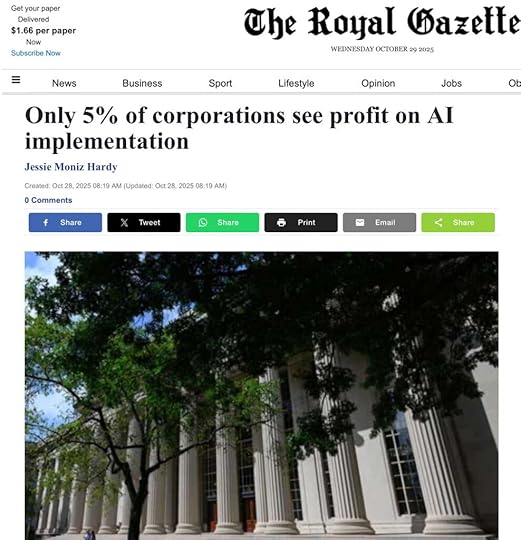
The Royal Gazette quotes Brian Solis in its article about the ROI of AI in business written by Jessie Moniz Hardy. 
Ninety-five per cent of enterprises that have invested in generative artificial intelligence have yet to make any profit from it, according to a new study from the Massachusetts Institute of Technology.
The report suggested that the AI revolution in most corporations is happening successfully at an individual employee level with tools such as ChatGPT and Microsoft’s Copilot, but is not going well at the corporate level.
The GenAI Divide: State of AI in Business 2025 was published by MIT’s Networked AI Agents in Decentralised Architecture project, which looks at the future of generative AI.
“The hype on LinkedIn says everything has changed, but in our operations, nothing fundamental has shifted,” one manufacturing executive told NANDA.
In response to the report, some commentators have insisted that the methodology of the MIT study was wrong.
Brian Solis, the futurist writer, was one. He has said technology is not the problem — humans are.
In a post on his Instagram page, Mr Solis said corporate America is stuck in the first phase of AI adoption.
“Too many executives are focused on using AI to do the same work, but with fewer people,” he said. “That may cut costs in the short term, but it is a short-term strategy that is not transformation.”
Mr Solis said the real opportunity lies in using AI to solve problems that could not be solved before and to create new products and new lines of business.
“That is where growth lives,” he said. “That is where new demand for labour is generated and not reduced.”
Read the full article here.
The post The Royale Gazette: Only 5% of corporations see profit on AI implementation appeared first on Brian Solis.
October 20, 2025
AI Adoption is an Act of Self-Disruption: An Interview with Invisible Machines
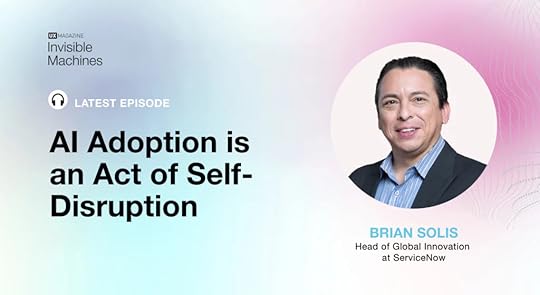
Brian Solis, is a digital anthropologist and futurist who serves as the Head of Global Innovation at ServiceNow and is the former Head of Global Innovation at Salesforce. Brian is a bestselling author of Mindshift, which helps leaders learn how to see emerging trends, harness disruptive forces, and use them to fuel growth.
Brian joins Robb and Josh, the authors of Invisible Machines, to talk with us about the importance of self-disruption in AI adoption. With so many genAI projects failing to reach production, this episode looks at approaches taken by IKEA and Airbnb that have induced the kind of mind shift that invites self-disruption. Brian, who’s been called the CEO whisperer, also talks about the nuanced difference between “aha” and “uh-oh” moments and the pitfalls of hopeless optimism.
Brian Solis’s works: https://briansolis.com/books/
AI Adoption is an Act of Self-Disruption ft Brian Solis, Head of Global Innovation at ServiceNowvia UX Magazine
What does it really take for businesses to successfully adopt AI? According to Brian Solis, digital anthropologist, futurist, and Head of Global Innovation at ServiceNow, it’s not just about new tools. It’s about self-disruption.
Dubbed “the CEO whisperer,” Brian brings decades of experience advising leaders at the highest levels. In this thought-provoking episode of Invisible Machines, he joins Robb Wilson and Josh Tyson to discuss why true AI adoption requires rethinking nearly every layer of business infrastructure, and how the C-suite mindset must shift to meet the challenge.
The conversation dives into:
What self-disruption looks like at the enterprise level.The difference between “ah-ha” moments and “uh-oh” moments in innovation.How storytelling can make or break technology adoption.Lessons from companies like IKEA and Airbnb that embraced self-disruption.Why hopeless optimism can be just as dangerous as resistance to change.What a future awash in simulations and predictions could look like.This is a brisk, jam-packed episode that offers both strategic insights and practical inspiration for leaders navigating the AI-first future. Tune in now to hear Brian Solis on Invisible Machines and discover why AI adoption is the ultimate act of self-disruption.
Key chapters0:00 — Intro
0:34 — Guest intro: Brian Solis (ServiceNow futurist, author of Mindshift)
1:07 — Why AI adoption requires self-disruption
1:26 — Aha vs Uh-oh moments with AI
5:30 — Why Brian is called the “CEO Whisperer”
8:30 — Rethinking failure & success (beyond SV mantras)
12:11 — Storytelling as strategy: Disney & Airbnb lessons
21:40 — MindShift: disruption as a deliberate choice
23:10 — Embrace complexity (the VC decision lens)
25:10 — Iteration vs innovation: redefining growth
29:00 — ROI vs “Return on Ignorance” (cost of not acting)
34:01 — Multiple futures & scenario planning
39:08 — Organizational AGI: companies as futurists
43:28 — IKEA case study: automation + augmentation
46:12 — NVIDIA & the power of simulations
Mindshift | Newsletter | Speaking
The post AI Adoption is an Act of Self-Disruption: An Interview with Invisible Machines appeared first on Brian Solis.
October 17, 2025
Innolead Interviews Brian Solis: Using AI to Support Innovation (and Iteration) at ServiceNow
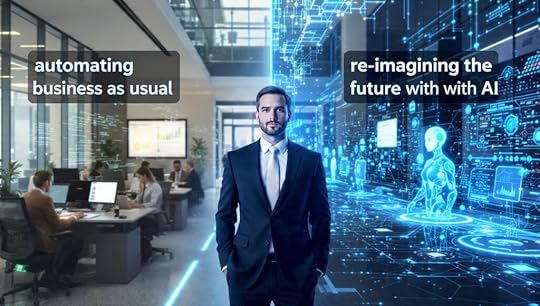
Every company says they “do AI.” Few can show meaningful outcomes.
We’ve been intentional about iteration and innovation. Iteration makes yesterday’s work more efficient. Innovation creates new value. When you separate the two, you can measure cost takeout and progress…and prioritize what matters.
When you separate the two, you can measure cost takeout and progress…and prioritize what matters.
If you’re leading transformation, ask: are your AI investments making yesterday cheaper…or creating tomorrow’s value?
Please read this awesome piece by Dawn Kawamoto for InnoLead and let’s talk about where your org sits on the AI iteration–innovation curve.
Using AI to Support Innovation (and Iteration) at ServiceNowSince its founding in 2004, Silicon Valley-based ServiceNow has been all about automating business workflows. So in the current AI era, the $11 billion company is focused on how various types of AI will support that automation. Often, ServiceNow’s own employees are “customer zero” for new offerings — early adopters for the products and services it builds.
Already, the company’s AI strategy is helping to reduce service volume by 40 percent, and generating millions in annualized value from AI agents that provide support to its 8,400 global customers.
Brian Solis, Head of Global Innovation at ServiceNow and author of the recent book Mindshift, recently spoke with InnoLead about the software-as-a-service giant’s deployment of AI; the results it’s producing; and the importance of defining both “iteration” and “innovation.”
Can you tell me about your role and how it’s defined?We have a unique office here. The innovation office is led by my boss, Dave Wright, our Chief Innovation Officer, and my job is to lead a group of what we call innovation officers and futurists in helping our customers and ourselves navigate all these disruptive trends and opportunities, especially now in an era of AI.
We also publish original research and thought leadership inspired by countless conversations with executives on the questions they have, the difficulties and challenges they’re trying to navigate, and also the opportunities that they may not see. Things are moving pretty fast, and it’s easy to react rather than plan ahead, so all that research and thought leadership is published. We’re now occasionally publishing it externally, and we’re also publishing internal-only insights for our executives to help them navigate these trends.
How is AI and GenAI being used at ServiceNow?What’s really interesting about ServiceNow is that we actually use our stuff, so that we can be “customer zero.” We have an organization within ServiceNow called Now on Now, which tells the ServiceNow story of how we utilize our products.
For example, with GenAI and, especially, AI agents, we utilize our agentic workforce. We’re using AI agents to resolve service tickets, apply system patches at scale proactively, and provide summaries to our human IT managers. And when it comes to scaling software provisioning for our 27,000 employees, it’s a prime opportunity for AI and AI agents.
What impacts have you seen from your internal use of AI and GenAI at ServiceNow?We’ve actually automated 97 percent of our provisioning requests and reduced service volume by 40 percent. We’re also using AI agents in customer support, which is an interesting use case because it demonstrates what we believe the story around AI needs to be — annualized value from AI agents, and we’re already realizing $350 million. But more importantly, when we can automate the routine, we’re freeing up our human agents to spend more time with customers in realizing value from their investments.
As you journey further into AI and GenAI, what are some of the challenges you are working through?If you consider how our company has grown over the past couple of decades, the platform we built from the very beginning was the challenge we faced then and still face today. That challenge comes from the legacy mindset companies have about software. Over the years, technology, data, and workflows have become beholden to silos. And now with AI, which feeds on data, it is as effective as the platform it runs on.
The challenge and opportunity for ServiceNow is to help change the mindsets of today’s organizational leaders to recognize that when they see studies like MIT’s, which says that 95 percent of AI investments aren’t realizing value, it’s because of the human capacity for implementing pilots within modern constructs.
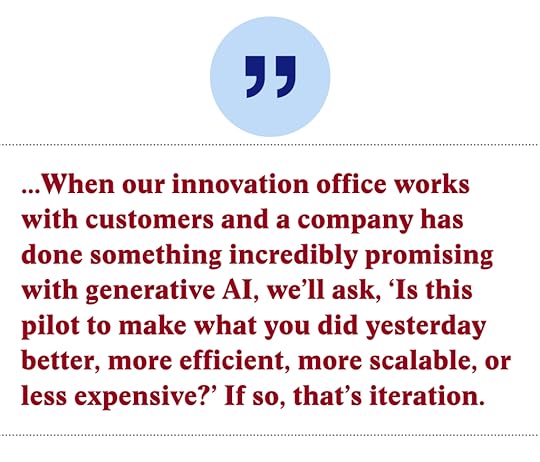
For example, when our innovation office works with customers and a company has done something incredibly promising with generative AI, we’ll ask, “Is this pilot to make what you did yesterday better, more efficient, more scalable, or less expensive?” If so, that’s iteration. Innovation is doing what you didn’t do yesterday to create new value.
An innovative pilot on a platform connects the organization, allowing work to move across the enterprise through a system that not only accomplishes tasks or outcomes but also connects data, various systems, and disparate data to gain insights into that work, workflow, and opportunities for optimization. That platform mindset is the challenge and opportunity we’re working on, because we want companies to finally see that after all these years of saying we need to break down silos, that one, you can, and two, you need to.
What percent of companies are instilling an innovative mindset, and what speed bumps are they having to deal with when using AI and GenAI?Our innovation office created a methodology and a maturity model that we call the AI Index. What we did was study how companies were and weren’t evolving with AI and where the more advanced companies were doing things differently than other companies. For example, the more innovative companies are creating AI innovation centers, not just innovation centers. AI innovation centers combine a center of excellence with a group of internal and external advisors who accelerate cross-functional pilots, so they’re not just locked into one part of the business. They’re not just learning about the technology, but everything that goes around it.
We identified five stages of AI maturity, and only 18 percent of companies are doing more innovative things than their peers. But compare that to a McKinsey study, which found that among all companies investing in AI for potential innovation, only one percent feel they are mature in that regard. An Axios study showed that 90 percent of C-suite executives say that their company has an AI strategy, but only 57 percent of employees agree.
It comes back to that balance between innovation and iteration. If you create a framework that defines what makes iteration and what makes innovation, and you assess those investments, you can then quantify whether the organization is innovative or iterative. When leaders see this is not as full as they’d like, this creates a sense of urgency. They want to learn how to be more innovative.
How do you build a culture of innovation? First, you have to recognize that you don’t have one, and second, you have to understand how people and behaviors, norms, vision, and future motivational states are articulated towards where an organization is going, and where I can see myself as an employee contributing to that. In that last part, most companies do not have innovative cultures, and therefore, they’re not as innovative, but they can be.
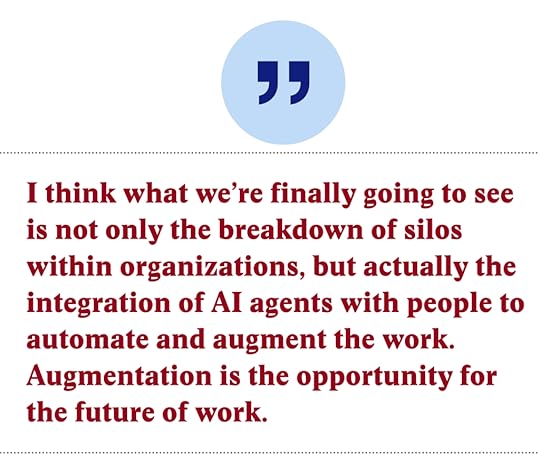
As a practicing futurist, there was a time when I had to look out 10 years, and it’s getting harder, especially how fast we’re moving. I think what we’re finally going to see is not only the breakdown of silos within organizations, but actually the integration of AI agents with people to automate and augment the work. Augmentation is the opportunity for the future of work.
Over the next three years, on the augmentation side, we’ll see humans and AI working together to accomplish net new types of outcomes. Think about it as a visual metaphor of you trying to push a big rock up the hill, which was impossible before, but now you have this big AI robot helping you push it up. It’s almost like a superpower to unlock new capacities and capabilities.
With this new future of work, we’ll invent new workflows to improve the performance of the organization. Legacy organizations, for example, will not only use automation to make yesterday’s value proposition more efficient to market, but also unlock new value creation for the company to deliver new relevance due to that new human-AI capacity.
Those new workflows will be fascinating because they’ll involve an orchestration of human employees who can perform new types of work with AI, as well as be augmented by agents. Maybe it’s not in three years, maybe it’s five years.
And looking more broadly at infusing an innovative mindset among the workforce, what are the greatest challenges leaders face and — more importantly — what are the workarounds for these challenges?One of the most difficult truths about innovation is that its primary obstacles are often human rather than technological in nature. Fixed mindsets are baked into how we’ve been taught to lead, manage, and measure progress. If you zoom out and look across most organizations, what you’ll find is that innovation isn’t lacking because people don’t have ideas. It’s lacking because the system around them is designed to optimize for predictability, efficiency, productivity, and other “knowns,” not possibilities or unknowns.
There’s a kind of unconscious bias embedded in many leadership playbooks, legacy thinking inherited from an industrial era. Stability was rewarded, and risk was averted. Scale and efficiency drove strategy and operations, and R&D supported those efforts. As a result, leaders have become more focused on quarter-to-quarter performance, with an emphasis on responding to today’s threats and opportunities. This means that many leaders are not looking…to future-proof their organizations and adapt to these emergent trends as part of the day-to-day innovation needed to out-compete their peers.
Mindshift | Newsletter | Speaking
The post Innolead Interviews Brian Solis: Using AI to Support Innovation (and Iteration) at ServiceNow appeared first on Brian Solis.
October 11, 2025
Are You Focused on the AI Bubble or the AI Bomb? The Gap That Defines Our Future.
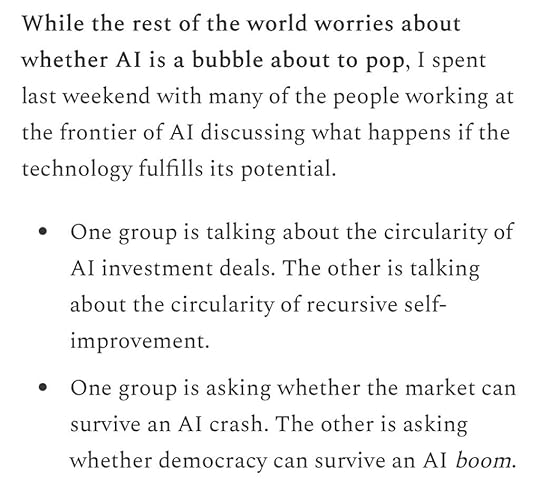
Sitting here at the Wharf in Sydney, thinking about the AI bubble and executive short-termism vs. waves of evolving scenarios where AI and agentic (and eventually autonomous) workflows change business, and societal, trajectories.
This was an interesting analysis on the current state of AI by Shakeel Hashim. His post, “We’re All Behind the Curve,” highlights a critical, often missed gap that determines who gets ahead and who gets left behind.
After speaking at the Curve Conference, he observed two distinct groups. Here’s how he described it, “I wrote about the very scary disconnect I felt between the conversations I was having…and the way the wider world talks about AI.”
The Curve is “where thinkers grapple with AI’s biggest questions, exploring disagreements and building bridges towards solutions.”
While one group focuses on the Hype Cycle and worries about the circularity of investment, market valuations, and whether the economy can survive an AI crash, the other group, working at the frontier of AGI, is grappling with fundamentally different, potentially game-changing questions…
The circularity of recursive self-improvement.
The impending culture war over AI personhood.
The risk of a US regime change driven by AI advances.
Whether democracy can survive the leap.
The focus on the economic alarm bells is generally an unproductive distraction, but I get it. The fear of a bubble-pop and its impact on the economy draws a visceral reaction by those still reeling from the last economic disaster. At the same time, waves of AI impact will change how we work and who or what we employ and why. It’s also helpful to listen to people with “situational awareness” of subjects we may not follow, understand, or care to understand.
If your strategy is still centered on navigating the next hype cycle phase, you are behind. The gravitas of this moment demands we immediately pivot from worrying about quarterly returns to solving problems like space governance and the future of human agency (and the future of people in an agentic or even autonomous enterprise).
Crash or not, the challenges over the horizon can eclipse anything we’ve faced. We are not spending nearly enough time exploring potential scenarios, and as a result, we are not preparing for alternate trajectories or futures.
This is the moment for a strategic mindshift. Join me in reshaping the future..
Subscribe to my newsletter, “A Quantum of Solis.”
The post Are You Focused on the AI Bubble or the AI Bomb? The Gap That Defines Our Future. appeared first on Brian Solis.
October 10, 2025
What Sets AI Pacesetters Apart? An Executive’s Guide To Advancing Enterprise AI
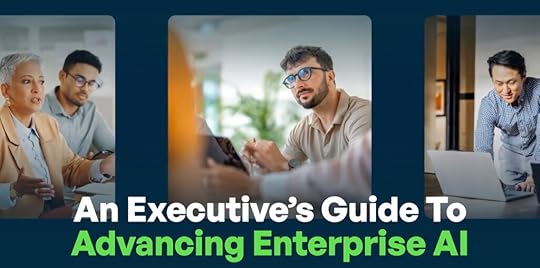
From 2023-2024, I studied how companies were and weren’t evolving in their adoption of generative AI. That research led to a framework for tracking enterprise AI maturity across eight pillars:
Vision and StrategyLeadershipData GovernanceAI GovernanceTalent, Skills, and DevelopmentWorkflowsResponsible AIMeasuresIn partnership with Richard Murphy and René Stranghoner, we turned a large and complicated spreadsheet into what ultimately became the ServiceNow AI Index. Launched initially in 2024 and again in 2025, we now have two years of insights that offer an idea of how companies are evolving, with some starkly maturing faster than others. We call these faster-moving companies AI Pacesetters.
To help other companies follow in the paths of their peers, we analyzed their steps and what they do differently. The result is this AI Pacesetter Playbook published in Forbes.
There’s a big difference between having a vision and being visionary. It all comes down to why you should do AI rather than how you should do AI,” ServiceNow Chief Innovation Officer Dave Wright told customers in May at the Knowledge 2025 event in Las Vegas.
Pacesetters understand this nuance better than most. They have a vision for what they want their organizations to achieve and use AI as a tool to get there.
Here’s what they do differently…
Lead With An Innovation MindsetWhile ingenuity gives pacesetters an edge, not all companies are set up for out-of-the-box thinking.
“For years, we have been taught to follow the rules to achieve goals — to not challenge convention,” Brian Solis, head of global innovation at ServiceNow, said at Knowledge. “Companies are meant to operate efficiently and meant to scale. They fight against risk.”
But AI is challenging the very nature of what it means to be an organization, he continued. Pacesetters are recognizing this shift and building AI innovation centers to nurture creativity.
Thinking expansively led a major insurance business to improve IT productivity and accelerate the creation of its service catalog. Each item in such a catalog — like installing a software patch — usually has a multi-step workflow. Using ServiceNow tools, the company automated some of the most significant ones for the first time.
When companies don’t have the option to dedicate more people or investment to fix a problem or chase an opportunity, they can turn to AI to identify smarter ways to deliver services.
56% of AI pacesetters strongly agree they are operating with an AI vision that is clear and shared,
compared with 30% of others.
 Take a platform approach
Take a platform approachPacesetters realize that consolidating departments onto a common platform unites teams, collapses information silos and fuels innovation, Wright said. It decreases the costs of harnessing and accessing data and instead enables employees to focus on the actual tasks at hand.
66% of AI pacesetters use an enterprise-wide platform with built-in AI capabilities, compared to 46% of others.
Focus on talent – Expand Your Hiring Criteria Beyond Technical AbilityOrganizations require technical expertise to understand how to build models. But they also need creative thinkers who can use AI to solve customer problems. Increasingly, tools like Now Assist, which is part of the ServiceNow platform, are making it easier to build autonomous chatbots, request summaries and code without dev expertise.
50% of pacesetters agree they have the right mix of talent to execute their AI strategy
compared with 29% of others.
Clear risk management guidelines help employees understand what the rules are, said Rachael Sandel, chief information officer at Orica. In 2024, the company released its own AI guidelines that aligned with industry standards and company values.
63% of pacesetters have created AI-specific policies and addressed needs in data governance and security,
compared with 42% of others.
Agentic AI — a type of artificial intelligence that acts autonomously to meet defined goals — has had barely a year to get out the gate, but it’s already delivering ROI for early adopters. According to the ServiceNow report, 55% of enterprises using agentic AI said it has already improved gross margins.
36% of pacesetters are using agentic AI, compared with 19% of others.
If you parse through the data, you’ll also see that they invest in a culture, or at least centers, of innovation.
Please read the playbook to learn what you can do differently, starting tomorrow.
As ServiceNow CEO Bill McDermott said, “Together, we have a great chance to shape the future, and incrementalism won’t do it. It’s time for change — to put AI to work for you.”
I’m currently working with the research team to update the research methodology with all the latest advancements in AI and how businesses are, and aren’t, transforming. Results due out in 2026!
The post What Sets AI Pacesetters Apart? An Executive’s Guide To Advancing Enterprise AI appeared first on Brian Solis.
October 5, 2025
What Would AI Do? Rethinking Transformation from Procurement to the Enterprise at DPW

Live from the floor of DPW in New York, I had the privilege of joining my long-time friend Mark Perera on the DPW podcast. We explored the future of technology, business, and leadership, while also looking back to our roots in Silicon Valley during the rise of Web 1.0, Web 2.0, Social Media, and smartphones.
What made it truly special wasn’t just the set, it was the conversations I had with procurement leaders, innovators, and partners before stepping up to speak on behalf of ServiceNow. Listening to their challenges, their questions, and even what they hadn’t yet thought about, fueled what I brought to the stage and the podcast, and beyond.
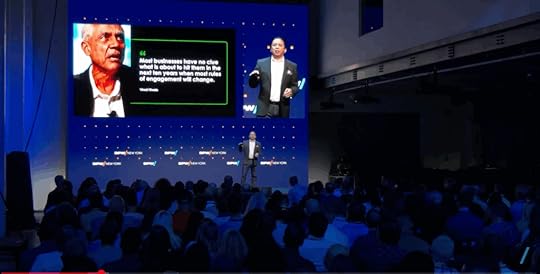
I’ve studied disruption and transformation in Silicon Valley and its impact around the world for a long time. Again and again, I’ve seen the same pattern: new technology arrives, and companies use it to optimize what they already do, just faster, cheaper, more efficient moving forward. That’s necessary, but it’s not transformative. And these times are in need of transformative strategies.
Please excuse the plug, but it’s honest in its intent. My latest book, Mindshift: Transform Leadership, Drive Innovation, and Reshape the Future,is about breaking that cycle. It’s about giving ourselves permission to think differently, anticipating change and what comes next before disruption forces our hand. More so, it shows how to do things differently.
The Shift: From What We Did to What Would AI Do? – #WWAIDThroughout history, businesses have applied every major wave of technology to optimize the past. We make existing processes faster, more efficient, less expensive, more scalable. That’s progress and it is valuable. At the same time, it can also hold us to iteration, aiming to do what we did yesterday better tomorrow.
AI, however, invites a different question: What if the goal isn’t just to improve yesterday’s processes, but to invent tomorrow’s possibilities?
That’s where I ask WWAID, or What Would AI Do?
It’s a mental framework I use to break free from my own biases, expertise, and assumptions. Instead of asking “what would I do with AI?,” a question tethered to my perceived worldview, I try to explore the unknown for growth, and ask, “what would AI do in this moment?”

This subtle shift changes everything.
For example, in the case of DPW, we could ask (but it’s easy to adapt the questions to any industry or space):
Instead of: How do we make procurement 10% faster?Ask: What would procurement look like if it was designed natively with AI at the core?Instead of: How do we reduce costs in supply chain management?Ask: What if AI could redesign the supply chain itself to deliver on customer promises, sustainability goals, or brand values—not just cost savings?Instead of: How do we train employees to use AI tools?Ask: How can humans and AI collaborate as partners, each amplifying the other’s strengths, to create outcomes that neither could deliver alone?Beyond the 10%: Unlocking Exponential ValueMany organizations are focused on incremental gains, “the 10% mindset.” They implement AI in pockets, see some efficiency, and check the box. But the real opportunity lies in connecting workflows across silos. We could also call this group, “the 95% crew” if you read the recent MIT reportthat purported that 95% of generative AI pilots fail. As I shared in a recent analysis of that study, if you want bigger and better outcomes, you have to be bolder and more imaginative than in the past.
If you do what you’ve always done, how can you expect different outcomes. Yet, we do.
McKinsey’s QuantumBlack recently studied an array of generative AI use cases and found the highest returns didn’t come from isolated projects. Out of 25 attributes tested for organizations of all sizes, the redesign of workflows had the biggest effect to see EBIT impact. Said another way, instead of AI making one function better, it made the entire enterprise smarter and more profitable.
For procurement, that means moving from being a cost optimizer to being a strategic value creator. But I guess this is true for every industry and function. Imagine AI not just automating sourcing steps, but orchestrating how procurement ties into supply chain, product development, sustainability, and customer experience. Again, this is true as you reimagine work and workflows. This is no longer incremental improvement, it’s now about unlocking business model reinvention.
Escaping the Iterative MindsetOne of the biggest barriers to innovation is psychological. Even when leaders are asked to “think outside the box,” they bring their own industry box with them. Any brainstorm is still constrained by prevailing biases and assumptions, just dressed up with new buzzwords.
To truly innovate, we need to temporarily suspend expertise. Look at the most innovative companies outside your industry. Study their culture, their organizational design, their use of AI. Ask: What lessons can we borrow? And ask, what are they not doing?
When you shift your frame of reference, you stop seeing AI as just another tool for efficiency. It suddenly becomes an ‘AI status quo.’ You start to see it as an invitation to reimagine what your function could become in service of growth, customer value, and future relevance.
Platforms, Agents, and the Future of WorkAt ServiceNow, we think of ourselves as the platform for AI-powered business transformation. AI by itself doesn’t transform businesses, it needs a foundation. And that foundation is rooted in mindset.
The future is agent-driven. Imagine workflows where the interface is the agent, where AI agents roam across siloed systems, pull in data, orchestrate processes, and deliver business outcomes without a human clicking through screens. In the process, they’re also learning, improving, and scaling in ways traditional IT stacks never could.
For leaders, this requires a mindset shift: stop reinforcing legacy processes with new tech. Instead, design workflows and strategies for the AI economy, a world where scale, speed, and creativity are no longer bound by headcount or historical silos.
My Personal MindshiftI live these conversations every day with companies all around the world. I experiment with wearables like the Limitless Pin, which records and structures conversations into small language models I can query later, and then connects to larger models for insight. I use Meta’s AI glasses not just as hardware, but as an extension of my capacity in the real world and also cognition, translating languages in real time, narrating historical context as I walk through cities, and augmenting my curiosity in ways I couldn’t before.
Each of these experiments challenges me to think differently. They remind me that AI doesn’t have to replace us, with vision, it can extend us. The outcomes are efficiency gains and they’re entirely new ways of living, working, and creating. But that’s up to you. Start by asking WWAID?
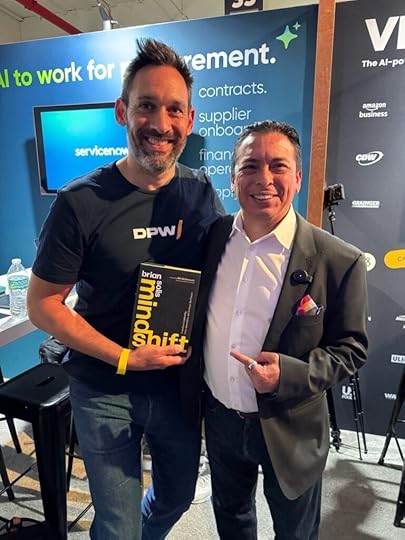
This is the moment for leaders to stop chasing incremental optimization and start defining what’s possible in an AI-driven future. Ask what would AI do if it were designing my function, my business, my industry from scratch? #WWAID
That’s where transformation begins. That’s where disruption becomes opportunity. And that’s the mindshift every leader needs to embrace.
—
 Please listen to my full conversation with DPW to hear these ideas explored in depth, and to start asking yourself: What would AI do? #WWAID
Please listen to my full conversation with DPW to hear these ideas explored in depth, and to start asking yourself: What would AI do? #WWAID
 Please watch my keynote at DPW NY.
Please watch my keynote at DPW NY.
Mindshift | Speaking | Newsletter
The post What Would AI Do? Rethinking Transformation from Procurement to the Enterprise at DPW appeared first on Brian Solis.




